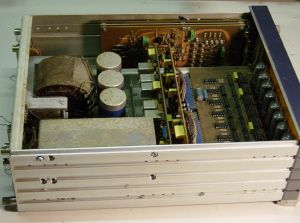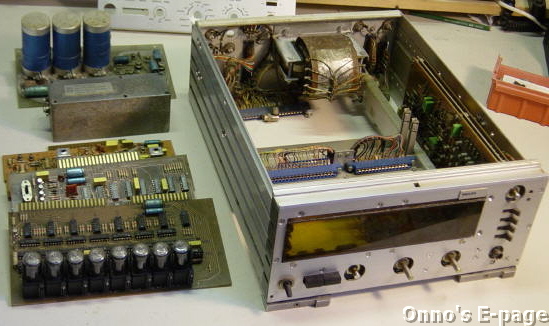Philips PM6630 frequency counter (1970?)


The PM6630 is a frequency counter-timer handling up to 160MHz or 10 ns pulse width. It comes in an aluminium and steel case apparently intended to be placed on a shelf, although it does have a tilt support for bench use. Its display has 8 ZM1000 nixies. It uses TTL for the digital circuitry, except for the high speed input stage and first counter decade.

A look from above, before cleaning.
I bought this counter in summer 2003 through an Internet auction site. The person who sold it, had used it himself. He told me it had a slight malfunction: it indicated twice the frequency, but this could be helped by setting a control on the inside, a potmeter. I decided I would have a go at repairing that.
The counter turned out to be greasy and a bit corroded inside. I thoroughly cleaned the inside and removed a number of circuit boards to reach all the corners. This gave me an opportunity to appreciate the way this instrument has been built. It is quite compact, and Philips have tried to make it service-friendly, but they fell a bit short of reaching that goal. As I found out later, especially the input circuits and first counter stage are awkward to service.

PM6630 partly disassembled for cleaning.
When I tried the counter, it turned out to work. But the display changed constantly. Comparing the reading with my FC7008 counter, I noticed the PM6630 flipped between twice and three times the real input frequency. Tracing the signal, I found that the first counter stage did not function properly. This is a discrete ring counter consisting of 10 transistors, 5 zeners and some ordinary diodes. It is followed by a discrete decoder that converts the counter state into BCD (Binary Coded Decimal) as input for an FJL101 (SN74141) decoder/driver IC. This counter circuit is subtle in its working. This is where the potmeter the previous owner mentioned, belongs. The potmeter sets a bias voltage for the counter stages. In the manual, you are instructed to set it until the counter is working properly and indicates the correct frequency. But the counter did not react properly. Whatever I did, I could not get a stable readout. When I tried to see what was happening on my scope and touched points in the counter circuit, it changed its behaviour. I only have a faint suspicion that the zener diodes have aged so that the different stages react differently. After trying for a few days, I gave up and put the counter on a shelf.

A look at the circuit boards and switches from the bottom.
Copyright © 2007 by Onno's E-page published 2007-04-07